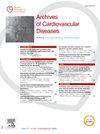Peptide-functionalized liposomes for cardiomyocyte targeting
IF 2.3
3区 医学
Q2 CARDIAC & CARDIOVASCULAR SYSTEMS
引用次数: 0
Abstract
Introduction
Cardiovascular diseases are the leading cause of death worldwide. While current pharmaceutical therapies are beneficial, they still have several limitations regarding efficacy and side effects. This issue stems from the inadequate targeting of cardiomyocytes and the difficulties that certain therapeutic molecules face in penetrating the intact cell membrane.
Objective
We aim to develop a delivery system specifically designed to target cardiomyocytes using liposomes functionalized with our cardiac-targeting peptides. We will evaluate their effectiveness in delivering therapeutic molecules directly to cardiomyocytes in vitro.
Method
PEGylated liposomes were produced using the thin lipid film hydration method followed by extrusion. The post-insertion method was used to functionalize the liposomes with various fluorescent labels and peptides. Additionally, direct labeling of liposomes with rhodamine was used to evaluate cellular internalization. Dissociated neonatal rat ventricular cardiomyocytes (NRVM) were incubated for two hours with rhodamine-liposomes to compare three formulations: naked liposomes (LipoRho), liposomes functionalized with the non-specific cell-penetrating peptide TAT (LipoRho + TAT), and liposomes functionalized with a specific cardiac-homing peptide (LipoRho + SCHoP) (Fig. 1).
Results
The produced liposomes exhibited a uniform population approximately 140 nm in size and had a negative surface charge. The optimized post-insertion protocol for functionalizing the liposomes showed an efficiency of about 80% for the SCHoP peptide. Spinning disk confocal images revealed that the liposomes successfully transduced cardiomyocytes. Specifically, LipoRho + TAT and LipoRho + SCHoP showed increased internalization in NRVM compared to non-functionalized liposomes (LipoRho).
Conclusion
This promising data tackles the unresolved challenge of targeting the heart tissue by demonstrating that a cardiac-targeting peptide can efficiently decorate a liposome surface and enhance its internalization in cardiomyocytes.
心肌细胞靶向的肽功能化脂质体
心血管疾病是世界范围内导致死亡的主要原因。虽然目前的药物治疗是有益的,但它们在疗效和副作用方面仍然存在一些局限性。这一问题源于对心肌细胞的靶向不足以及某些治疗分子在穿透完整细胞膜时面临的困难。我们的目标是开发一种专门设计的递送系统,使用我们的心脏靶向肽功能化的脂质体靶向心肌细胞。我们将评估它们在体外将治疗分子直接输送到心肌细胞中的有效性。方法采用脂膜水化法制备聚乙二醇化脂质体。采用后插入法用各种荧光标记和多肽功能化脂质体。此外,用罗丹明直接标记脂质体用于评估细胞内化。分离的新生大鼠心室心肌细胞(NRVM)与罗丹明脂质体一起孵育两小时,以比较三种配方:裸脂质体(LipoRho),脂质体与非特异性细胞穿透肽TAT (LipoRho + TAT)功能化,脂质体与特异性心脏归巢肽(LipoRho + SCHoP)功能化(图1)。结果所制得的脂质体大小均匀,约为140 nm,表面带负电荷。优化的插入后脂质体功能化方案显示,SCHoP肽的功能化效率约为80%。旋转盘共聚焦图像显示脂质体成功转导了心肌细胞。具体而言,与非功能化脂质体(LipoRho)相比,LipoRho + TAT和LipoRho + SCHoP在NRVM中的内化程度增加。这一有希望的数据通过证明心脏靶向肽可以有效地修饰脂质体表面并增强其在心肌细胞中的内化,解决了尚未解决的靶向心脏组织的挑战。
本文章由计算机程序翻译,如有差异,请以英文原文为准。
求助全文
约1分钟内获得全文
求助全文
来源期刊

Archives of Cardiovascular Diseases
医学-心血管系统
CiteScore
4.40
自引率
6.70%
发文量
87
审稿时长
34 days
期刊介绍:
The Journal publishes original peer-reviewed clinical and research articles, epidemiological studies, new methodological clinical approaches, review articles and editorials. Topics covered include coronary artery and valve diseases, interventional and pediatric cardiology, cardiovascular surgery, cardiomyopathy and heart failure, arrhythmias and stimulation, cardiovascular imaging, vascular medicine and hypertension, epidemiology and risk factors, and large multicenter studies. Archives of Cardiovascular Diseases also publishes abstracts of papers presented at the annual sessions of the Journées Européennes de la Société Française de Cardiologie and the guidelines edited by the French Society of Cardiology.
 求助内容:
求助内容: 应助结果提醒方式:
应助结果提醒方式:


